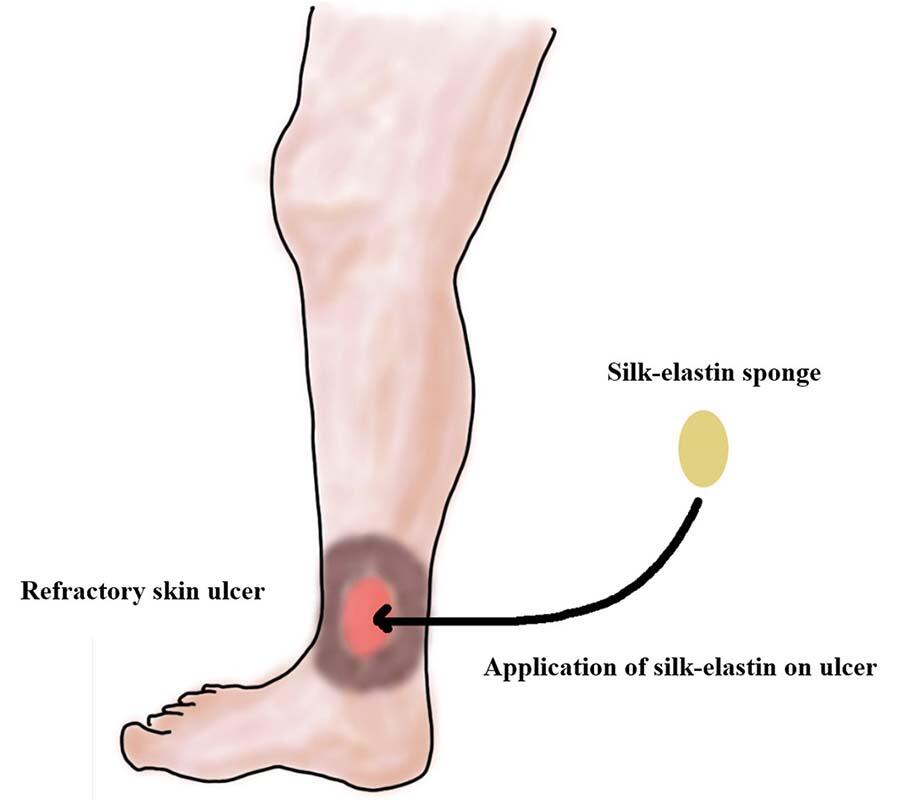Professor Naoki Morimoto of Kyoto University Graduate School of Medicine and Sanyo Chemical Industries Ltd. (President and CEO, Akinori Higuchi) announced on July 9th that they have started a corporate clinical trial to verify the effectiveness of the artificial protein "Silk Elastin" for the treatment of chronic wounds. During the trial it will be applied to intractable wounds, such as diabetic foot ulcers, at five medical institutions nationwide, including Kyoto University Hospital. The group is aiming for practical application by 2023.
The silk elastin developed by Sanyo Chemical Industries Ltd. is a material produced via recombinant technology, modifying the Escherichia coli gene by introducing partial sequences of silk fibroin and elastin to produce silk elastin. When established, it will be the first medical device in Japan that uses genetic modification (recombinant) technology. The silk elastin aqueous solution possesses a thermosetting property by which it forms irreversible gels via self-association when heated to 37 °C. The company can process the material into films, sponges, and fibers using its unique interface control technology. A "silk elastin sponge" is prepared by processing silk elastin into a sponge-like form and will be used in the clinical trials.
The two organizations started joint research in 2010; following initial animal experiments, and a physician-initiated clinical trial was conducted in a small number of patients in 2018. These clinical trials confirmed the safety of silk elastin. It was also confirmed that macrophage migration and bacterial growth suppression occurred during the healing process, fibroblast migration and collagen production were promoted during the proliferative phase, and epithelialization was promoted during the maturation phase. The gelled "silk elastin sponge" serves as a scaffold for cells and promotes the formation of granulation tissue. The gel covers the entire wound, allow for suppression of the growth of bacteria. The "silk elastin sponge" forms a liquid following administration owing to the exudate of the wound; this means that the patient needs to remain stationary for some time after administration but can move freely after gelation. The sponge can also be easily cut and administered according to the shape of the injury. The administered "silk elastin sponge" gel is finally absorbed as the wound heals.

Credit: Sanyo Chemical Industries Ltd.
The corporate clinical trial will involve patients with intractable skin defect wounds that did not respond to or are considered to be untreatable with existing standard treatments. It will be performed on a total of 25 cases, including 20 chronic wounds (such as diabetic ulcers) and 5 acute wounds (second-degree burns or higher), until November. Patients who currently visit medical institutions for treatment will not be recruited for the trial.
Typical chronic wounds include diabetic foot ulcers, venous stasis ulcers, and pressure ulcers; these do not heal for more than 4 weeks, have inflammation, and do not respond effectively to antibacterial drugs. In particular, diabetic foot ulcers occur in up to 10% of the approximately 10 million diabetes patients in Japan, and exacerbations result in 3 to 4 thousand cases of foot amputation annually. Usually, the choice of wound treatment depends on the wound depth; if the dermis remains, a wound dressing or ointment is used; if the defect extends further, negative pressure wound therapy or artificial dermis (collagen sponge) is used. Chronic wounds show decreased blood flow, and in diabetes, bacterial infections are likely to occur owing to weakened immunity, making the wounds difficult to heal.
This article has been translated by JST with permission from The Science News Ltd.(https://sci-news.co.jp/). Unauthorized reproduction of the article and photographs is prohibited.



